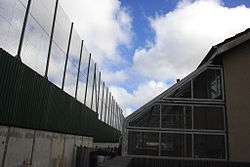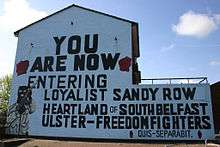Ghetto
_Panorama.jpg)
A ghetto (Italian pronunciation: [ɡetˈto]) is a part of a city in which members of a minority group live, typically as a result of social, legal, or economic pressure.[1] The term may have originally been used in Venice to describe the part of the city to which Jews were restricted and segregated. However, early societies may have formed their own versions of the same structure; words resembling "ghetto" appear in the Hebrew, Yiddish, Italian, Germanic, Old French, and Latin languages. The word "ghetto" itself is being used as an adjective in the English language. Ghettos in many cities have also been nicknamed "the hood", colloquial slang for neighborhood.[2] Versions of ghettos appear across the world, each with their own names, classifications, and groupings of people.
Etymology
The word "ghetto" comes from the Jewish area of Venice, the Venetian Ghetto in Cannaregio, traced to a special use of Venetian getto, or "foundry" (there was one near the site of that city's ghetto in 1516).[3] By 1899 the term had been extended to crowded urban quarters of other minority groups.
The etymology of the word is uncertain, as there is no agreement among etymologists about the origins of the Venetian language term. Theories include that it comes from the above-mentioned Venetian ghèto (foundry); from Hebrew get ("bill of divorce", "deed of separation"), from the Yiddish gehektes (enclosed), from Latin Giudaicetum, (Jewish), from the Italian borghetto (little town) "small section of a town" (diminutive of borgo, which is of Germanic origin; see borough), from the Old French guect (guard).[4] Another possibility is a clipped form of Egitto ("Egypt"), from Latin Aegyptus (presumably in memory of exile).
United Kingdom
Northern Ireland
In Northern Ireland, towns and cities have long been segregated along ethnic, religious and political lines. Northern Ireland's two main communities are its Irish nationalist-republican community (who mainly self-identify as Irish or Catholic) and its unionist-loyalist community (who mainly self-identify as British or Protestant). Ghettos emerged in Belfast during the riots that accompanied the Irish War of Independence. For safety, people fled to areas where their community was the majority.
Many more ghettos emerged after the 1969 riots and beginning of the "Troubles". In August 1969 the British Army was deployed to restore order and separate the two sides. The government built barriers called "peace lines". Many of the ghettos came under the control of paramilitaries such as the (republican) Provisional Irish Republican Army and the (loyalist) Ulster Defence Association. One of the most notable ghettos was Free Derry.[5]
Great Britain
The existence of ethnic enclaves in the United Kingdom is controversial. Southall Broadway, a predominantly Asian area in London, where less than 12 percent of the population is white, has been cited as an example of a 'ghetto', but in reality the area is home to a number of different ethnic groups and religious groups.[6][7] Analysis of data from Census 2001 revealed that only two wards in England and Wales, both in Birmingham, had one dominant non-white ethnic group comprising more than two-thirds of the local population, but there were 20 wards where whites were a minority making up less than a third of the local population.[8][9] By 2001, two London boroughs – Newham and Brent – had 'minority majority' populations, and most parts of the city tend to have a diverse population.
Denmark
Denmark is the only country to officially use the word 'ghetto' to denote certain residential areas.[10] The legal designation is applied to areas based on the residents' income levels, employment status, education levels, criminal convictions and 'non-Western' ethnic background.[11][12][13] In 2017, the population of Denmark was 5.7 million, of which 8.7% were non-Western immigrants or their descendants. The population proportion of 'ghetto residents' with non-Western background was 66.5%.[14] Since 2010, the Danish Ministry of Transport, Building and Housing publishes the ghettolisten (List of ghettos) which in 2018 consists of 25 areas.[10][11] In his New Year Speech for 2018, the Danish Prime Minister Lars Løkke Rasmussen announced his government's intention to "end the existence of parallel societies and ghettos by 2030".[13][15] The government has since proposed measures to solve the issue of integration which include policies like 30 hours of obligatory daycare per week for 'ghetto children' starting age 1, lowering social welfare for ghetto residents, incentives for reducing unemployment, demolition and rebuilding of certain tenements, doubling punishment for certain crimes like theft and vandalism in the ghettos, rights for landlords to refuse housing to convicts, etc.[15][16] While some proposals like restricting 'ghetto children' to their homes after 8 p.m. have been rejected for being too radical, most of the 22 proposals have been agreed upon by a parliamentary majority.[10][12] The policies have been criticized for undercutting 'equality before law' and for portraying immigrants, especially Muslim immigrants, in a bad light.[11][17]
France
In France, a banlieue (French: [bɑ̃ljø]) is a suburb of a large city. Banlieues are divided into autonomous administrative entities and do not constitute part of the city proper. For instance, 80% of the inhabitants of the Paris area live outside the city of Paris.[18] Like the city centre, suburbs may be rich, middle-class or poor—Versailles, Le Vésinet, Maisons-Laffitte and Neuilly-sur-Seine are affluent banlieues of Paris, while Clichy-sous-Bois, Bondy and Corbeil-Essonnes are less so. However, since the 1970s, banlieues increasingly means, in French of France, low-income housing projects (HLMs) in which mainly foreign immigrants and French of foreign descent reside, often in perceived poverty traps.[19]
Jewish ghettos
Europe
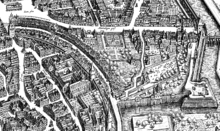
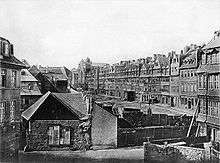
A Jewish quarter is the area of a city traditionally inhabited by Jews in the diaspora. Jewish quarters, like the Jewish ghettos in Europe, were often the outgrowths of segregated ghettos instituted by the surrounding authorities. A Yiddish term for a Jewish quarter or neighborhood is Di yiddishe gas (Yiddish: די ייִדדישע גאַס ), or "The Jewish street". Many European and Middle Eastern cities once had a historical Jewish quarter.
Jewish ghettos in Europe existed because Jews were viewed as alien. As a result, Jews were placed under strict regulations throughout many European cities.[20] The character of ghettos has varied through times.
In some cases, the ghetto was a Jewish quarter with a relatively affluent population (for instance the Jewish ghetto in Venice). In other cases, ghettos were places of terrible poverty and during periods of population growth, ghettos (as that of Rome), had narrow streets and tall, crowded houses. Residents had their own justice system.
Jewish ghettos in Nazi-occupied Europe
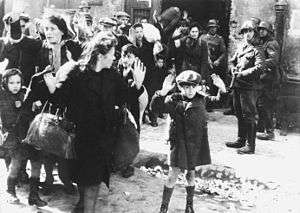
During World War II, ghettos were established by the Nazis to confine Jews and Romani people into tightly packed areas of the cities of Eastern Europe. The Nazis most often referred to these areas in documents and signage at their entrances as "Jewish quarter". These Nazi ghettos sometimes coincided with traditional Jewish ghettos and Jewish quarters, but not always. On June 21, 1943, Heinrich Himmler issued a decree ordering the dissolution of all ghettos in the East and their transformation into Nazi concentration camps.[21]
Morocco
A mellah (Arabic ملاح, probably from the word ملح, Arabic for "salt") is a walled Jewish quarter of a city in Morocco, an analogue of the European ghetto. Jewish populations were confined to mellahs in Morocco beginning from the 15th century and especially since the early 19th century. In cities, a mellah was surrounded by a wall with a fortified gateway. Usually, the Jewish quarter was situated near the royal palace or the residence of the governor in order to protect its inhabitants from recurring riots. In contrast, rural mellahs were separate villages inhabited solely by the Jews.
Israel
According to Jewish writer Robert Gessner, who travelled to Palestine in the 1930s, Tel Aviv had a ghetto for poorer Jews.[22]
Shanghai ghetto
The Shanghai Ghetto was an area of approximately one square mile in the Hongkou District of Japanese-occupied Shanghai to which about 20,000 Jewish refugees were relocated by the Japanese-issued Proclamation Concerning Restriction of Residence and Business of Stateless Refugees after having fled from German-occupied Europe before and during World War II.[23]
Palestine
Many people refer to the Gaza Strip as a ghetto, which is debated.[24][25][26][27] The film Gaza Ghetto was made in 1984 documenting a family in the region.[28]
United States
History
.jpeg)
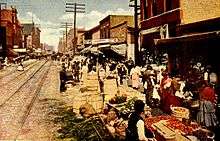
The development of ghettos in the United States is closely associated with different waves of immigration and internal urban migration. The Irish and German immigrants of the mid-19th century were the first ethnic groups to form ethnic enclaves in United States cities. This was followed by large numbers of immigrants from Southern and Eastern Europe, including many Italians and Poles between 1880 and 1920. These later European immigrants were more segregated than blacks in the early twentieth century.[29] Most of these remained in their established immigrant communities, but by the second or third generation, many families were able to relocate to better housing in the suburbs after World War II.
These ethnic ghetto areas included the Lower East Side in Manhattan, New York, which later became notable as predominantly Jewish, and East Harlem, which became home to a large Puerto Rican community in the 1950s. Little Italys across the country were predominantly Italian ghettos. Many Polish immigrants moved to sections like Pilsen of Chicago and Polish Hill of Pittsburgh. Brighton Beach in Brooklyn is the home of mostly Russian and Ukrainian immigrants.
During the Great Depression, many people would congregate in large open parking lots. They built shelters out of whatever materials they could find at the time. These congregations of shelters were also called "ghettos".
African-American or Black ghettos
A commonly used definition of a ghetto is a community distinguished by a homogeneous race or ethnicity. Additionally, a key feature that developed throughout the postindustrial era and continues to symbolize the demographics of American ghettos is the prevalence of poverty. Poverty constitutes the separation of ghettos from other, suburbanized or private neighborhoods. The high percentage of poverty partly justifies the difficulty of out-migration, which tends to reproduce constraining social opportunities and inequalities in society.[30]
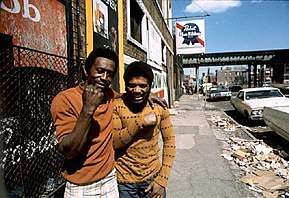
Urban areas in the U.S. can often be classified as "black" or "white", with the inhabitants primarily belonging to a homogenous racial grouping.[31] Forty years after the Civil Rights Movement, most of the United States remains a residentially segregated society in which blacks and whites inhabit different neighborhoods of significantly different quality.[31][32]
Many of these neighborhoods are located in Northern cities where African-Americans moved during the Great Migration (1914–1950), a period when over a million[33] African-Americans moved out of the rural Southern United States to escape the widespread racism of the South, to seek out employment opportunities in urban environments, and to pursue what was widely perceived to be a better quality of life in the North.[33]
Two main factors ensured further separation between races and classes, and ultimately the development of contemporary ghettos: the relocation of industrial enterprises, and the movement of middle to upper class residents into suburban neighborhoods. Between 1967 and 1987, economic restructuring resulted in a dramatic decline of manufacturing jobs. The once thriving northern industrial cities directed a shift to service occupations and in combination with the movement of middle-class families and other businesses to the suburbs, left much economic devastation in the inner cities. Consequently, African-Americans were disproportionately affected and became either unemployed or underemployed with little wage and reduced benefits. Accordingly, a concentration of African-Americans was established in the inner city neighbourhoods of places such as New York, Chicago and Detroit.[30]
It is also significant to compare the demographic patterns between blacks and European immigrants, according to the labor market. European immigrants and African-Americans were both subject to an ethnic division of labor, and consequently African-Americans have predominated in the least secure division of the labor market. David Ward refers to this stagnant position in African-American or Black ghettos as the 'elevator' model, which implies that each group of immigrants or migrants takes turns in the processes of social mobility and suburbanization; and several groups did not start on the ground floor. The inability of blacks to move from the ground floor, as Ward suggests, is dependent upon prejudice and segregationist patterns experienced in the South prior to World War I. After the exodus of African-Americans to the North, the range of occupations in the North was further altered by the settlement of European immigrants; thus, African-Americans were diminished to unskilled jobs. The slow rate of advancement in black communities outlines the rigidity of the labor market, competition and conflict, adding another dimension to the prevalence of poverty and social instability in African-American or Black ghettos.[34]
World War II's Effect on the Development of Ghettos
In the years following World War II, many white Americans began to move away from inner cities to newer suburban communities, a process known as white flight. White flight occurred, in part, as a response to black people moving into white urban neighborhoods.[35][36] Discriminatory practices, especially those intended to "preserve" emerging white suburbs, restricted the ability of blacks to move from inner cities to the suburbs, even when they were economically able to afford it. In contrast to this, the same period in history marked a massive suburban expansion available primarily to whites of both wealthy and working-class backgrounds, facilitated through highway construction and the availability of federally subsidized home mortgages (VA, FHA, HOLC). These made it easier for families to buy new homes in the suburbs, but not to rent apartments in cities.[37]
The United States began restructuring its economy after World War II, fueled by new globalizing processes, and demonstrated through technological advances and improvements in efficiency. The structural shift of 1973, during the postfordist era, became a large component to the racial ghetto and its relationship with the labor market. Sharon Zukin declares the designated stratum of African-Americans in the labor force was placed even below the working class; low-skill urban jobs were now given to incoming immigrants from Mexico or the Caribbean. Additionally, Zukin notes, "Not only have social services been drastically reduced, punitive and other social controls over the poor have been increased," such as law enforcement and imprisonment.[38][39] Described as the "urban crisis" during the 1970s and 1980s, the transition stressed regional divisions according to differences in income and racial lines – white "donuts" around black holes.[40] Hardly coincidental, the steady separation occurred during the period of civil rights laws, urban riots and Black Power. In addition, the International Encyclopedia of Social Sciences stresses the various challenges developed by this "urban crisis", including:
poorly underserviced infrastructures, inadequate housing to accommodate a growing urban populace, group conflict and competition over limited jobs and space, the inability for many residents to compete for new technology-based jobs, and tensions between the public and private sectors left to the formation and growth of U.S. ghettos.[30][41]
The cumulative economic and social forces in ghettos give way to social, political and economic isolation and inequality, while indirectly defining a separation between superior and inferior status of groups.
In response to the influx of black people from the South, banks, insurance companies, and businesses began denying or increasing the cost of services, such as banking, insurance, access to jobs,[42] access to health care,[43] or even supermarkets[44] to residents in certain, often racially determined,[45] areas. The most devastating form of redlining, and the most common use of the term, refers to mortgage discrimination. Data on house prices and attitudes toward integration suggest that in the mid-twentieth century, segregation was a product of collective actions taken by non-blacks to exclude blacks from outside neighborhoods.[46]
The "Racial" Provisions of the FHA Underwriting Manual of 1936 included the following guidelines which exacerbated the segregation issue:
Recommended restrictions should include provision for: prohibition of the occupancy of properties except by the race for which they are intended ... Schools should be appropriate to the needs of the new community and they should not be attended in large numbers by inharmonious racial groups.[35][47]
This meant that ethnic minorities could secure mortgage loans only in certain areas, and it resulted in a large increase in the residential racial segregation and urban decay in the United States.[48] The creation of new highways in some cases divided and isolated black neighborhoods from goods and services, many times within industrial corridors. For example, Birmingham, Alabama's interstate highway system attempted to maintain the racial boundaries that had been established by the city's 1926 racial zoning law. The construction of interstate highways through black neighborhoods in the city led to significant population loss in those neighborhoods and is associated with an increase in neighborhood racial segregation.[49] Residential segregation was further perpetuated because whites were willing to pay more than blacks to live in predominantly white areas.[29] Some social scientists suggest that the historical processes of suburbanization and decentralization are instances of white privilege that have contributed to contemporary patterns of environmental racism.[50]
Following the emergence of anti-discrimination policies in housing and labor sparked by the civil rights movement, members of the black middle class moved out of the ghetto. The Fair Housing Act was passed in 1968. This was the first federal law that outlawed discrimination in the sale and rental of housing on the basis of race, color, national origin, religion and later sex, familial status, and disability. The Office of Fair Housing and Equal Opportunity was charged with administering and enforcing the law. Since housing discrimination became illegal, new housing opportunities were made available to the black community and many left the ghetto. Urban sociologists frequently title this historical event as "black middle class exodus" (also see black flight). Elijah Anderson describes a process by which members of the black middle class begin to distance themselves socially and culturally from ghetto residents during the later half of the twentieth century, "eventually expressing this distance by literally moving away."[51] This is followed by the exodus of black working-class families.[52]:49 As a result, the ghetto becomes primarily occupied by what sociologists and journalists of the 1980s and 1990s frequently title the "underclass." William Julius Wilson suggests this exodus worsens the isolation of the black underclass – not only are they socially and physically distanced from whites, they are also isolated from the black middle class.[52]:7–8
Race-Based vs. Class-Based Theories on the Development of U.S. Ghettos
Two dominant theories arise pertaining to the production and development of U.S. ghettos. First are the race-based theorists who argue the importance of race in ghettos. Their analysis consists of the dominant racial group in the U.S. (White Anglo-Saxon Protestants) and their use of certain racist tactics in order to maintain their hegemony over blacks and lengthen their spatial separation. Race-based theorists offset other arguments that focus on the influence of the economy on segregation. More contemporary research of race-based theorists is to frame a range of methods conducted by white Americans to "preserve race-based residential inequities" as a function of the dominantly white, state-run government. Involving uneven development, mortgage and business discrimination and disinvestment – U.S. ghettos then, as suggested by race-based theorists, are conserved by distinctly racial reasoning. The more dominant view, on the other hand, is represented by class-based theorists. Such theories confirm class to be more important than race in the structuring of U.S. ghettos. Although racial concentration is a key signifier for ghettos, class-based theorists emphasize the role and impact of broader societal structures in the creation of African-American or Black ghettos. Dynamics of low-wage service and unemployment triggered from deindustrialization, and the intergenerational diffusion of status within families and neighborhoods, for instance, prove the rise in socioeconomic polarization between classes to be the creator of American ghetto; not racism.[53] Furthermore, the culture of poverty theory, first developed by Oscar Lewis, states that a prolonged history of poverty can itself become a cultural obstacle to socioeconomic success, and in turn can continue a pattern of socioeconomic polarization. Ghettos, in short, instill a cultural adaptation to social and class-based inequalities, reducing the ability of future generations to mobilize or migrate.[40]
An alternative theory put forward by Thomas Sowell in Black Rednecks and White Liberals asserts that modern urban black ghetto culture is rooted in the white Cracker culture of the North Britons and Scots-Irish who migrated from the generally lawless border regions of Britain to the American South, where they formed a redneck culture common to both blacks and whites in the antebellum South. Characteristics of this culture included lively music and dance, violence, unbridled emotions, flamboyant imagery, illegitimacy, religious oratory marked by strident rhetoric, and a lack of emphasis on education and intellectual interests.[54] Because redneck culture proved counterproductive, "that culture long ago died out...among both white and black Southerners, while still surviving today in the poorest and worst of the urban black ghettos",[55] which Sowell described as being characterized by "brawling, braggadocio, self-indulgence, [and] disregard of the future",[55] and where "belligerence is considered being manly and crudity is considered cool, while being civilized is regarded as 'acting white'."[54] Sowell blames liberal Americans who since the 1960s have embraced black ghetto culture as the only "'authentic' black culture and even glamorize it" while they "denounce any criticism of the ghetto lifestyle or any attempt to change it".[54] Sowell asserts that white liberal Americans have perpetuated this "counterproductive and self-destructive lifestyle" among black Americans living in urban ghettos through "the welfare state, and look-the-other-way policing, and smiling at 'gangsta rap'."[55]
Characterizations of "Ghetto" in the United States
Contemporary African-American or Black ghettos are characterized by an overrepresentation of a particular ethnicity or race, vulnerability to crime, social problems, governmental reliance and political disempowerment. Sharon Zukin explains that through these reasons, society rationalizes the term "bad neighborhoods". Zukin stresses that these circumstances are largely related to "racial concentration, residential abandonment, and deconstitution and reconstitution of communal institutions."[39][56] Many scholars diagnose this poorly facilitated and fragmented view of the United States as the "age of extremes". This term argues that inequalities of wealth and power reinforce spatial separation; for example, the growth of gated communities can be interconnected with the continued "ghettoization" of the poor.[40]
Another characteristic to African-American or Black ghettos and spatial separation is the dependence on the state, and lack of communal autonomy; Sharon Zukin refers to Brownsville, Brooklyn, as an example. This relationship between racial ghettos and the state is demonstrated through various push and pull features, implemented through government subsidized investments, which certainly assisted the movement of white Americans into the suburbs after World War II. Since the 1960s, after the deconstitution of the inner cities, African-American or Black ghettos have attempted to reorganize or reconstitute; in effect, they are increasingly regarded as public- and state-dependent communities. Brownsville, for instance, initiated the constitution of community-established public housing, anti-poverty organizations, and social service facilities – all, in their own way, depend on state resources. However, certain dependence contradicts society's desires to be autonomous actors in the market. Moreover, Zukin implies, "the less 'autonomous' the community – in its dependence on public schools, public housing and various subsidy programs – the greater the inequity between their organizations and the state, and the less willing residents are to organize."[39][57] This should not, on the other hand, undermine local development corporations or social service agencies helping these neighborhoods. The lack of autonomy and growing dependence on the state, especially in a neoliberal economy, remains a key indicator to the production as well as the prevalence of African-American or Black ghettos, particularly due to the lack of opportunities to compete in the global market.[39]
Despite mainstream America's use of the term "ghetto" to signify a poor, culturally or racially homogenous urban area, those living in the area often used it to signify something positive. The black ghettos did not always contain dilapidated houses and deteriorating projects, nor were all of its residents poverty-stricken. For many African-Americans, the ghetto was "home": a place representing authentic blackness and a feeling, passion, or emotion derived from rising above the struggle and suffering of being black in America.[58] Langston Hughes relays in the "Negro Ghetto" (1931) and "The Heart of Harlem" (1945): "The buildings in Harlem are brick and stone/And the streets are long and wide,/But Harlem's much more than these alone,/Harlem is what's inside." Playwright August Wilson used the term "ghetto" in Ma Rainey's Black Bottom (1984) and Fences (1987), both of which draw upon the author's experience growing up in the Hill District of Pittsburgh, a black ghetto.[29]
The concept of 'the ghetto' and 'underclass' has faced criticism both theoretically and empirically. Research has shown significant differences in resources for neighborhoods with similar populations both across cities and over time.[59][60][61] This includes differences in the resources of neighborhoods with predominantly low income or racial minority populations. The cause of these differences in resources across similar neighborhoods has more to do with dynamics outside of the neighborhood.[62][63] To a large extent the problem with the 'ghetto' and 'underclass' concepts stem from the reliance on case studies (in particular case studies from Chicago), which limit social scientist understandings of socially disadvantaged neighborhoods.
Modern Usage and Reinterpretations of "Ghetto"
Recently the word "ghetto" has been used in slang as an adjective rather than a noun. It is used to indicate an object's relation to the inner city or black culture, and also more broadly to denote something that is shabby or of low quality. While "ghetto" as an adjective can be used derogatorily, the African-American or Black community, particularly the hip hop scene, has taken the word for themselves and begun using it in a more positive sense that transcends its derogatory origins.
In 1973, Geographical Review claimed "The degree of residential segregation of the black community is greater than for any other group in urban America, yet the blacks have not had the political power necessary to exercise any significant degree of control over the improvement of the basic services necessary for their health, education, and welfare."[64][65] Scholars have been interested in the study of African-American or Black ghettos precisely for the concentration of disadvantaged residents and their vulnerability to social problems. American ghettos also bring attention to geographical and political barriers, and as Doreen Massey highlights, that racial segregation in African-American or Black ghettos challenge America's democratic foundations.[40] However, it is still advocated that "One solution to these problems depends on our ability to use the political process in eliminating the inequities... geographical knowledge and theory to public-policy decisions about poor people and poor regions is a professional obligation."[64][65]
Gay ghetto
A gay village (also known as a gay neighbourhood or 'gayborhood', gay enclave, gay village, gaytto, "Boystown") is a geographical area with generally recognized boundaries, inhabited or frequented by a large number of lesbian, gay, bisexual, and transgender (LGBT) people. Unlike other ghettos, gay villages can be created by the LGBT community as an act of self-protection or even gentrification. Gay villages often contain a number of gay-oriented establishments, such as gay bars and pubs, nightclubs, bathhouses, restaurants, boutiques and bookstores.[2]
See also
References
- ↑ "Definition of GHETTO". www.merriam-webster.com. Retrieved 5 July 2017.
- 1 2 Kelefa, Sanneh (July 18, 2016). "There Goes the Neighborhood". The New Yorker. Retrieved 2 September 2016.
- ↑ see Calimani, Riccardo (1987) The Ghetto of Venice. New York: M. Evans & Co. ISBN 0871314843 pp. 129–132
- ↑ Domonoske, Camila (April 27, 2014). "Segregated From Its History, How 'Ghetto' Lost Its Meaning". NPR. Retrieved 20 November 2017.
The word "ghetto" is an etymological mystery. Is it from the Hebrew get, or bill of divorce? From the Venetian ghèto, or foundry? From the Yiddish gehektes, "enclosed"? From Latin Giudaicetum, for "Jewish"? From the Italian borghetto, "little town"? From the Old French guect, "guard"?...In his etymology column for the Oxford University Press, Anatoly Liberman took a look at each of these possibilities. He considered ever more improbable origins — Latin for "ribbon"? German for "street"? Latin for "to throw"? — before declaring the word a stubborn mystery.
- ↑ "History Battle of the Bogside". The Museum of Free Derry. 2015-07-31. Archived from the original on 2015-07-31. Retrieved 2017-04-17.
- ↑ Browne, Anthony (May 5, 2004). "We cant run away from it white flight is here too". The Times. London. Retrieved May 3, 2010.
- ↑ Kerr, J., Gibson, A. and Seaborne, M. (2003) London from Punk to Blair. Reaktion Books. see entries
- ↑ Archived Archived September 30, 2007, at the Wayback Machine.
- ↑ Shepherd, Anne. "British Society for Population Studies – British Society for Population Studies – Research centres, societies and groups – Department of Social Policy – Home". www.lse.ac.uk. Retrieved 5 July 2017.
- 1 2 3 Nielson, Emil Gjerding. "In Danish 'ghettos', immigrants feel stigmatized and shut out". U.S. Retrieved 2018-07-04.
- 1 2 3 "In Denmark's Plan To Rid Country Of 'Ghettos,' Some Immigrants Hear 'Go Home'". NPR.org. Retrieved 2018-07-04.
- 1 2 "In Denmark, Harsh New Laws for Immigrant 'Ghettos'". Retrieved 2018-07-04.
- 1 2 "Danes to double penalty for ghetto crime". BBC News. 2018-02-27. Retrieved 2018-07-04.
- ↑ Editorial, Reuters. "Denmark to school 'ghetto' kids in democracy and Christmas". U.S. Retrieved 2018-07-04.
- 1 2 "Here's what we know about Denmark's 'ghetto plan'". 2018-02-28. Retrieved 2018-07-04.
- ↑ "What to Know About Denmark's Plan to End Immigrant "Ghettos"". Time. Retrieved 2018-07-04.
- ↑ ""No ghettos in 2030": Denmark's controversial plan to get rid of immigrant neighborhoods". Vox. Retrieved 2018-07-04.
- ↑ "Archived copy". Archived from the original on 2013-10-29. Retrieved 2013-08-14.
- ↑ Lepoutre, David. Coeur de banlieue: codes, rites, et langages. Odile Jacob, 1997.
- ↑ GHETTO Kim Pearson Archived February 24, 2009, at the Wayback Machine.
- ↑ Ghetto in Flames Yitzhak Arad, pp. 436–437
- ↑ Robert Gessner, Some of my best friends are Jews (New York, 1936), p. 81; Matthias Hambrock
- ↑ Shanghai Jewish History Archived 2006-08-13 at the Wayback Machine. (Shanghai Jewish Center)
- ↑ LeVine, Mark. "Gaza is no Warsaw Ghetto". www.aljazeera.com. Retrieved 19 July 2017.
- ↑ Editorial, Haaretz (17 May 2016). "It's Been a Decade. Open Gaza, the Palestinian Ghetto". Retrieved 19 July 2017 – via Haaretz.
- ↑ "Prescott's 'concentration camp' Gaza comments anger British Jews". Retrieved 19 July 2017.
- ↑ "Palestinians are Warsaw Ghetto prisoners of today". RT International.
- ↑ "Gaza Ghetto: Portrait of a Palestinian Family". New Day Films. 2013-06-30. Retrieved 2017-07-19.
- 1 2 3 Ghettos: The Changing Consequences of Ethnic Isolation
- 1 2 3 Darity, William A., Jr., ed. "Ghetto." International Encyclopedia of the Social Sciences 3.2 (2008): 311–14. Gale Virtual Reference Library. Web. October 25, 2012.
- 1 2 Sethi, Rajiv; Somanathan, Rohini (2004). "Inequality and Segregation". Journal of Political Economy. 112 (6): 1296–1321. CiteSeerX 10.1.1.19.6596. doi:10.1086/424742.
- ↑ Massey, Douglas S. (2004). "Segregation and Stratification: A Biosocial Perspective". Du Bois Review. 1 (1): 7–25. doi:10.1017/S1742058X04040032.
- 1 2 "Retired Site – PBS Programs – PBS". Retired Site – PBS Programs – PBS. Retrieved 5 July 2017.
- ↑ Ward, David (1982). "The Ethnic Ghetto in the United States: Past and Present". Transactions of the Institute of British Geographers. ns. 7 (3): 257–75. JSTOR 621990.
- 1 2 Keating, William Dennis (1994). The Suburban Racial Dilemma: Housing and Neighborhoods. Temple University Press. ISBN 978-1-56639-147-4.
- ↑ Frey, William H. (1979). "Central City White Flight: Racial and Nonracial Causes". American Sociological Review. 44 (3): 425–448. JSTOR 2094885.
- ↑ "Racial" Provisions of FHA Underwriting Manual Archived December 29, 2008, at the Wayback Machine.
- ↑ Zukin 514
- 1 2 3 4 Zukin, Sharon (2002). "How 'Bad' Is It?: Institutions and Intentions in the Study of the American Ghetto". International Journal of Urban and Regional Research. 22 (3): 511–20. doi:10.1111/1468-2427.00155.
- 1 2 3 4 Fischer, Claude S.; Stockmayer, Gretchen; Stiles, Jon; Hout, Michael (2004). "Distinguishing the Geographical Levels and Social Dimensions of U.S. Metropolitan Segregation, 1960–2000". Demography. 41 (7): 37–59. doi:10.1353/dem.2004.0002.
- ↑ Darity 313
- ↑ Racial Discrimination and Redlining in Cities Archived November 30, 2007, at the Wayback Machine.
- ↑ See: Race and health
- ↑ Eisenhauer, Elizabeth (2001). "In poor health: Supermarket redlining and urban nutrition". GeoJournal. 53 (2): 125–133. doi:10.1023/A:1015772503007.
- ↑ Thabit, Walter, How East New York Became a Ghetto. ISBN 0-8147-8267-1. Page 42.
- ↑ Cutler, David M.; Glaeser, Edward L.; Vigdor, Jacob L. (1999). "The Rise and Decline of the American Ghetto". Journal of Political Economy. 107 (3): 455–506. CiteSeerX 10.1.1.587.8018. doi:10.1086/250069.
- ↑ Federal Housing Administration, Underwriting Manual: Underwriting and Valuation Procedure Under Title II of the National Housing Act with Revisions to February, 1938 (Washington, D.C.), Part II, Section 9, Rating of Location.
- ↑ Jackson, Kenneth T. (1985), Crabgrass Frontier: The Suburbanization of the United States, New York: Oxford University Press, ISBN 0-19-504983-7
- ↑ Connerly, Charles E. (2002). "From Racial Zoning to Community Empowerment: The Interstate Highway System and the African American Community in Birmingham, Alabama". Journal of Planning Education and Research. 22 (2): 99–114. doi:10.1177/0739456X02238441.
- ↑ Pulido, Laura (2000). "Rethinking Environmental Racism: White Privilege and Urban Development in Southern California". Annals of the Association of American Geographers. 90 (1): 12–40. doi:10.1111/0004-5608.00182. hdl:10214/1833.
- ↑ Anderson, Elijah (1990). Streetwise: Race, Class, and Change in an Urban Community. The University of Chicago Press. p. 2. ISBN 978-0-226-01816-4.
- 1 2 Wilson, William Julius (1987). The Truly Disadvantaged: The Inner City, the Underclass, and Public Policy. The University of Chicago Press. ISBN 978-0-226-90131-2.
- ↑ Shelton, Jason E. "Ghetto." Encyclopedia of Race, Ethnicity, and Society. 2008. SAGE Knowledge. Web. 25 Oct. 2012.
- 1 2 3 Sowell, Thomas (May 16, 2015). "Black Rednecks and White Liberals". Capitalism Magazine.
- 1 2 3 Nordlinger, Jay (September 9, 2005). ""Black Rednecks and White Liberals", by Thomas Sowell". National Review.
- ↑ Zukin 516
- ↑ Zukin 517
- ↑ Smitherman, Geneva (2000). Black Talk: Words and Phrases from the Hood to the Amen Corner. New York: Houghton Mifflin Company. ISBN 978-0-395-96919-9.
- ↑ "Symposium on the Ghetto". City & Community. 7 (4): 305–407. 2008. doi:10.1111/cico.2008.7.issue-4.
- ↑ Small, Mario L.; McDermott, Monica (2006). "The Presence of Organizational Resources in Poor Urban Neighborhoods: An Analysis of Average and Contextual Effects". Social Forces. 84 (3): 1697–1724. doi:10.1353/sof.2006.0067.
- ↑ Thibodeaux, Jarrett (2015). "A Historical Era of Food Deserts". Social Currents. 3 (2): 186–203. doi:10.1177/2329496515604639.
- ↑ Logan, John; Molotch, Harvey (1987). Urban Fortunes : The Political Economy of Place. Berkeley: University of California Press. ISBN 978-0-520-06341-9.
- ↑ Thibodeaux, Jarrett (2016). "City racial composition as a predictor of African American food deserts". Urban Studies. 53 (11): 2238–2252. doi:10.1177/0042098015587848.
- 1 2 Geographical Review 107
- 1 2 "Geographical Record". Geographical Review. 63 (1): 106–17. 1973. JSTOR 213241.
![]()
| Look up ghetto in Wiktionary, the free dictionary. |
